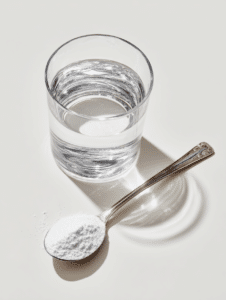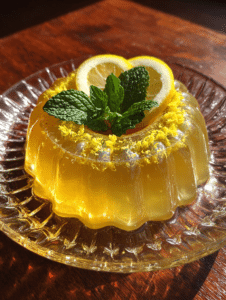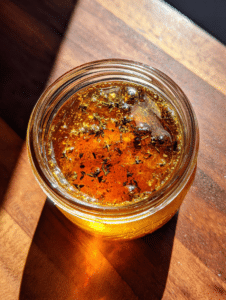Disclaimer: This content is for educational purposes only, not medical advice. Always consult with a doctor before making significant changes to your diet, especially if you have pre-existing health conditions.
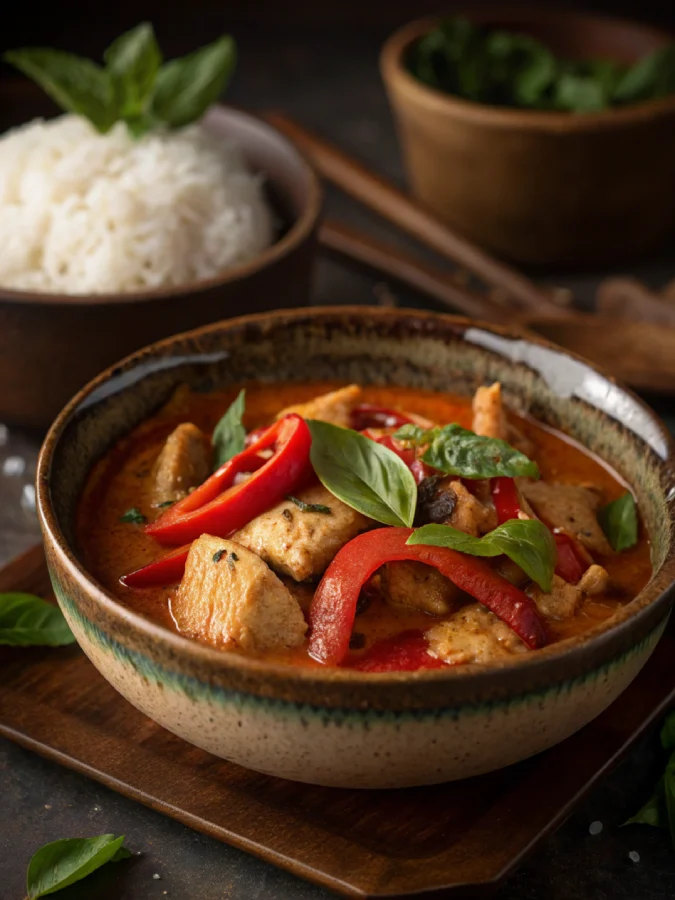
Red Thai curry is the kind of dish that hits every note, bold, spicy, creamy, and deeply satisfying. It’s a classic of Thai cuisine, but also one of the easiest curries you can make at home. With the right ingredients and a hot pan, you’ll go from fridge to fragrant, flavor-packed dinner in under 30 minutes.
My own red Thai curry obsession started in a weekend cooking class outside Austin. I was the only one who had never cooked with curry paste before. But once I sautéed it in hot oil and added coconut milk, the whole kitchen transformed. It was warm, spicy, floral, and shockingly simple.
That night, I recreated the recipe at home, and now red Thai curry is one of my family’s most requested weeknight meals. It’s endlessly adaptable. You can keep it vegetarian with bell peppers, zucchini, and eggplant, or load it with chicken or shrimp for a heartier bowl. Either way, you’re getting something rich in flavor and surprisingly light.
This is the kind of dish that aligns with our EatWellWell philosophy: quick, nourishing meals made with love. Like our pink salt diet drink recipe or chia green juice method, this curry feels good and tastes even better.
If you’re new to Thai flavors, this is a great first step. And if you’re already a fan, this might become your go-to version.
In this Article
Key takeaways: What You Need To Know
- Red Thai curry is a classic Thai dish made with curry paste, coconut milk, and vegetables or protein.
- It’s fast, flexible, and full of bold, balanced flavor.
- This curry is naturally gluten-free and can be vegan or low-carb depending on what you add.
- Coconut milk gives it creaminess while lime juice adds brightness.
- Perfect for a quick weeknight meal that still feels special.
What Ingredients Go Into a Thai Red Curry?

A proper red Thai curry starts with bold, aromatic ingredients that build layer upon layer of flavor. At its core, it’s a harmony of spice, creaminess, and brightness, but to achieve that, you need to choose each element with intention.
The Core Ingredients in a Red Thai Curry
Here’s what you’ll need to make a classic red Thai curry:
- Red curry paste: This is the heart of the dish, made from dried red chilies, lemongrass, garlic, shallots, galangal, kaffir lime peel, and shrimp paste (or soy-based alternatives for vegan versions).
- Coconut milk: Always choose full-fat coconut milk. It adds creaminess, balances the spice, and makes the curry luxuriously rich.
- Protein or vegetables: Chicken, tofu, shrimp, or seasonal vegetables like zucchini, bell peppers, eggplant, and bamboo shoots work beautifully.
- Fish sauce or soy sauce: Adds depth and umami.
- Palm sugar or brown sugar: Balances the heat and salt.
- Lime juice and Thai basil: These are added at the end to bring brightness and aroma.
If you’ve made nourishing pantry dishes like our chia seeds in yogurt recipe or experimented with smart swaps in our apple cider vinegar detox drink, you’ll find these ingredients easy to stock and reuse.
Store-Bought vs Homemade Red Curry Paste
Both options work, but they offer different strengths. Here’s how they compare:
| Type | Pros | Cons |
|---|---|---|
| Store-Bought | Fast, consistent flavor, widely available | Can contain preservatives or shrimp paste (non-vegan) |
| Homemade | Customizable, fresher flavor, cleaner ingredients | Takes time, requires hard-to-find ingredients |
Tip: If you’re short on time, go for brands like Mae Ploy or Thai Kitchen (look for preservative-free labels). Want full control over spice and flavor? Make your own paste, it’s worth it.
For deeper nourishment tips on pantry swaps and flavor upgrades, don’t miss our Japanese pink salt recipe.
What Is Red Thai Curry Chicken?
Red Thai curry chicken is the protein-packed version of the classic Thai dish, made by simmering tender chicken pieces in a spicy red curry sauce rich with coconut milk and aromatics. It’s one of the most popular variations of red Thai curry, especially in Western kitchens, and for good reason. Chicken absorbs the creamy curry beautifully while adding heartiness and flavor.
While traditional red Thai curry is highly customizable with vegetables and tofu, the chicken version gives it more depth and makes it a complete one-pot meal. You’ll find this dish in Thai restaurants across the U.S., often served with steamed jasmine rice, and increasingly in home kitchens for weeknight dinners.
Why Chicken Works So Well in Thai Red Curry
Chicken, especially boneless, skinless thighs, is ideal for simmered dishes like red Thai curry. It stays juicy, takes on flavor quickly, and holds its texture even after reheating. If you prefer leaner options, chicken breast works too, just simmer gently to avoid overcooking.
Red Thai curry chicken balances the heat of curry paste, the creaminess of coconut milk, and the savoriness of chicken in a way that’s both comforting and exciting. It’s a natural upgrade for anyone who already enjoys mild, spiced stews or skillet meals like our chia and pink salt tonic.
Pro Tip: Add chicken first, then stir in vegetables halfway through simmering. This keeps both elements perfectly cooked.
If you’ve been experimenting with functional meals like the cranberry vinegar detox, you’ll appreciate how this dish pairs wholesome proteins with bold flavors for something deeply satisfying and smartly balanced.
How to Make Red Thai Curry Chicken (Step-by-Step)
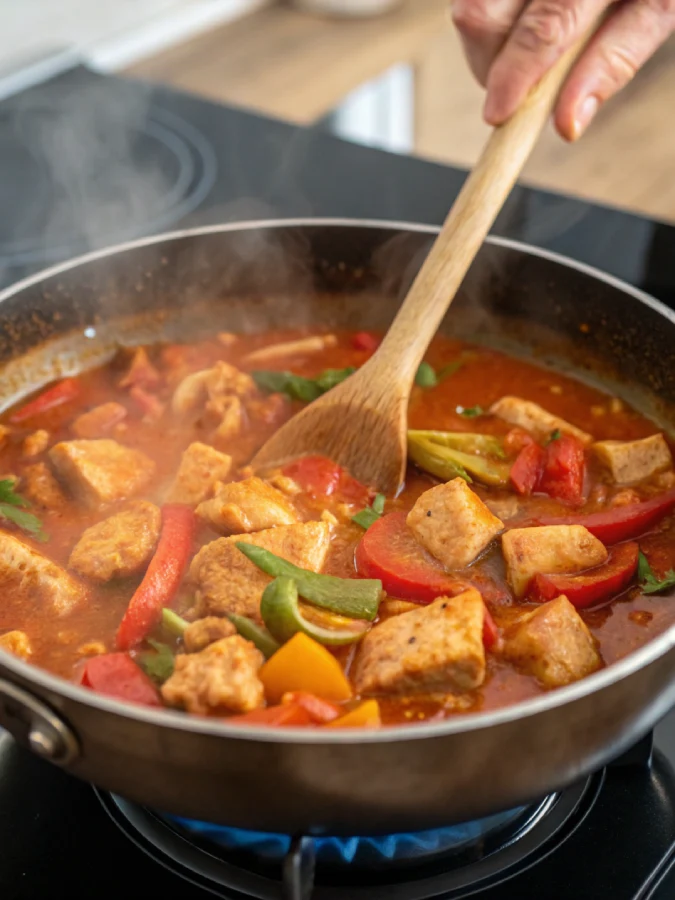
Making red Thai curry chicken at home is easier than you think. With just one pot and a few pantry staples, you can create a restaurant-quality meal in 30 minutes. The key is to build flavor in layers: sauté, simmer, then finish with brightness.
Here’s how to cook this satisfying, deeply flavored red Thai curry without overcomplicating a thing.
Ingredients You’ll Need
- 1 tablespoon red curry paste
- 1 tablespoon neutral oil (like avocado or canola)
- 1 can (13 oz) full-fat coconut milk
- 1/2 pound boneless chicken thighs or breasts, thinly sliced
- 1 1/2 cups mixed vegetables (bell peppers, zucchini, green beans)
- 1 tablespoon fish sauce (or soy sauce for vegan option)
- 1 teaspoon brown sugar or palm sugar
- Juice of 1 fresh lime
- Handful of Thai basil leaves (or regular basil)
Step-by-Step Instructions
- Heat oil in a saucepan over medium heat. Add red curry paste and sauté for 30–60 seconds until fragrant.
- Pour in half of the coconut milk, stirring constantly. Simmer for 2–3 minutes to blend flavors.
- Add chicken slices and stir to coat in the curry mixture. Let cook 3–5 minutes.
- Add remaining coconut milk and bring to a gentle simmer. Stir in vegetables.
- Simmer for 10 minutes or until chicken is cooked and vegetables are just tender.
- Add fish sauce, brown sugar, and lime juice. Taste and adjust seasoning.
- Stir in fresh basil leaves just before serving.
- Serve hot with jasmine rice or rice noodles.
Tip: Add vegetables halfway through so they don’t overcook. Stirring occasionally prevents the coconut milk from separating.
This bold, satisfying meal pairs beautifully with the hydration-supporting pink salt diet drink or as part of a clean eating dinner routine you can revisit week after week.

Red Thai Curry Chicken
Equipment
- 1 Saucepan or Wok Medium size, deep pan
- 1 Wooden Spoon For stirring curry evenly
- 1 Knife For slicing chicken/veg
- 1 Cutting Board
Ingredients
- 1 tbsp Red curry paste Adjust for heat level
- 1 tbsp Neutral oil Canola or avocado oil
- 1 can Coconut milk Full-fat 13 oz
- 1/2 lb Chicken boneless Thinly sliced, thighs or breasts
- 1.5 cups Mixed vegetables Bell peppers zucchini, green beans
- 1 tbsp Fish sauce Or soy sauce for vegan version
- 1 tsp Brown sugar Or palm sugar
- 1 Lime juice Freshly squeezed
- 1 handful Thai basil leaves Or regular basil
- Cooked jasmine rice For serving
Instructions
- Heat oil in a saucepan over medium heat.
- Add red curry paste and sauté for 30–60 seconds until fragrant.
- Pour in half the coconut milk and cook 2–3 minutes.
- Stir in chicken and cook for 3–5 minutes until it turns opaque.
- Add remaining coconut milk and vegetables. Simmer 10 minutes.
- Stir in fish sauce, sugar, and lime juice. Adjust seasoning to taste.
- Add basil leaves. Serve with hot jasmine rice.
Notes
Nutrition
How to Know When Red Thai Curry Is Perfectly Done
Knowing when your red Thai curry is done is all about watching for texture, aroma, and color. If you’ve followed the steps correctly, your kitchen should already smell incredible, but there are specific signs that tell you your curry is truly ready to serve.
Look for These Visual Cues
The most noticeable sign your red Thai curry chicken is done is the appearance of a thin red oil layer floating on top of the sauce. That oil comes from the curry paste separating slightly from the coconut milk, this is a good thing. It means the curry paste has fully released its flavor.
Also, check the chicken. It should be firm, opaque, and easy to cut with the edge of a spoon. If you’re using chicken breast, don’t overcook it, it should still be tender and juicy.
Vegetables should be just fork-tender, not mushy. Bell peppers and zucchini should hold their shape and keep a little bite for texture.
Taste for Balanced Flavor
Once your red Thai curry is simmered and the ingredients are cooked, taste your sauce. Is it too spicy? Add a dash of coconut milk or a pinch of sugar. Too sweet? A splash of fish sauce or soy sauce will rebalance it. Lacking brightness? Fresh lime juice does wonders.
If you’ve tried our apple peel weight loss recipe or the cranberry vinegar drink, you know how powerful acidity is in lifting flavors. The same principle applies here.
Final Tip: Resting Improves Flavor
Let your red Thai curry chicken sit for 5–10 minutes before serving. The flavors settle, and the sauce thickens just slightly, creating a deeper, more cohesive taste. It’s one of those dishes that’s even better reheated the next day.
What’s the Difference Between Red and Yellow Thai Curry?
Though both delicious and rooted in Thai cuisine, red Thai curry and yellow Thai curry are quite different in taste, color, and ingredients. Understanding the contrast helps you choose the right curry depending on your flavor preference and heat tolerance.
Color and Ingredients
Red Thai curry gets its deep reddish hue from dried red chilies, which are blended into the curry paste alongside lemongrass, garlic, galangal, and sometimes shrimp paste. It’s bold, spicy, and aromatic, with a slightly smoky edge.
Yellow Thai curry, on the other hand, uses turmeric as a base spice, along with cumin, coriander, and mild chili powder. The result is a bright golden curry with a more mellow, earthy flavor profile and much less heat.
Here’s a quick side-by-side comparison:
| Feature | Red Thai Curry | Yellow Thai Curry |
|---|---|---|
| Main Spice | Red chilies | Turmeric |
| Heat Level | Medium to hot | Mild |
| Flavor Profile | Spicy, bold, aromatic | Earthy, sweet, mild |
| Color | Red | Golden yellow |
When to Choose Red vs Yellow
Go for red Thai curry when you want spice and bold flavor, ideal for chilly evenings or when you’re craving something vibrant. Choose yellow Thai curry when you want something milder, kid-friendly, or with chicken and potatoes for a comforting meal.
If you enjoy building flavor with minimal effort, like our Japanese pink salt tonic, you’ll love how both curries bring something unique to the table.
📚 For more on Thai curry types and regional differences, visit the trusted Wikipedia article on Thai curry.
Is Thai Red Curry Spicy or Not? And Can You Control the Heat?
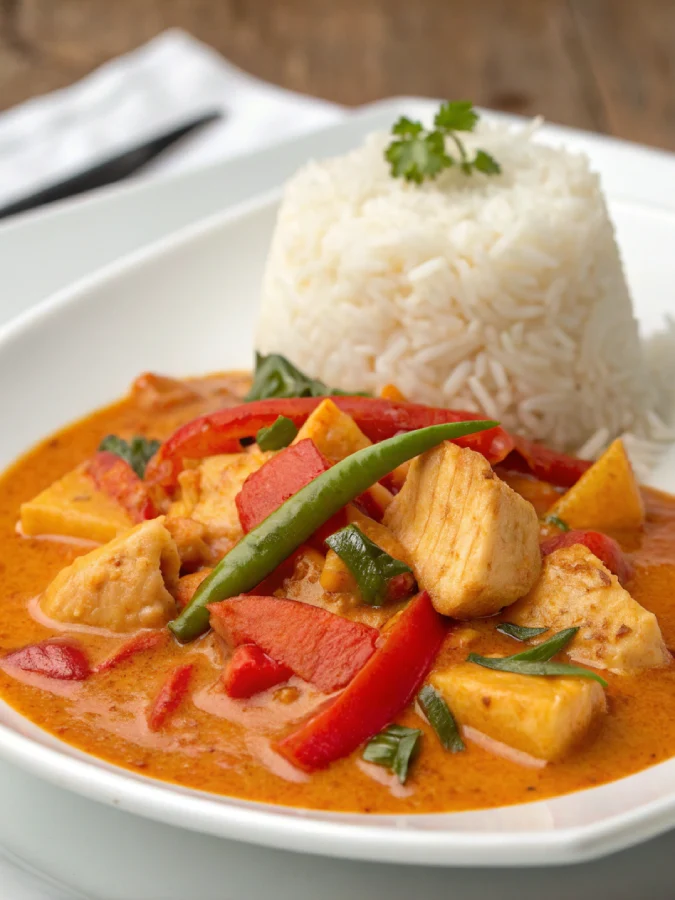
Red Thai curry is traditionally considered a medium to hot dish, but its heat can be adjusted easily depending on your taste. The level of spiciness mostly depends on the brand or blend of red curry paste you use, and how much you add to the dish.
How Spicy Is Red Thai Curry, Really?
Authentic Thai red curry paste is made with dried red chilies, which give it that deep, penetrating heat. While it’s not as fiery as green curry (which uses fresh chilies), it still brings a steady, warm burn, especially when concentrated.
That said, many store-bought curry pastes (like Thai Kitchen or Mae Ploy) are milder than homemade versions. You can start with 1 tablespoon of paste for gentle heat or go up to 2+ tablespoons for a spicier dish.
Tip: Always start small. You can add heat, but you can’t take it away.
How to Make Red Thai Curry Less Spicy
If you want a milder red Thai curry, here are a few easy adjustments:
- Use less curry paste (start with ½ tablespoon).
- Add extra coconut milk to dilute the heat.
- Mix in a teaspoon of brown sugar to soften the spice.
- Finish with fresh lime juice, which neutralizes some of the heat.
- Choose mild vegetables like zucchini, carrots, or sweet potato to absorb heat.
These tweaks are especially helpful if you’re serving kids or prefer gentle, flavorful warmth, similar to our apple peel weight-loss recipe or the cranberry detox that balances flavor with function.
Why Thai Curry Spice Is Good for You
Capsaicin, the compound that gives chilies their heat, has been studied for its metabolism-boosting and digestive benefits. According to MyPlate.gov, incorporating spicy foods in moderation can help improve flavor satisfaction without the need for heavy fats or salt.
So yes, red Thai curry is spicy, but with a purpose. And with the right tweaks, it can suit any spice tolerance level.
Frequently Asked Questions
What ingredients go into a Thai red curry?
A traditional red Thai curry includes red curry paste, coconut milk, chicken or tofu, a mix of vegetables like bell peppers or zucchini, fish sauce, sugar, lime juice, and fresh herbs like Thai basil. These elements combine to create a rich, balanced, and slightly spicy dish.
How to know when red Thai curry is perfectly done?
Your red Thai curry is done when the chicken is fully cooked, the vegetables are just tender, and a thin red oil layer rises to the top, signaling the curry paste has fully released its flavor. The sauce should be slightly thickened and bursting with aroma.
Does red Thai curry contain coconut milk?
Yes. Coconut milk is a foundational ingredient in red Thai curry. It provides the creamy base that balances the spice from red chilies and gives the curry its signature richness. Always use full-fat coconut milk for the best texture and depth.
What is red Thai curry chicken?
Red Thai curry chicken is a variation of Thai red curry that includes sliced chicken simmered in red curry paste and coconut milk. It’s one of the most popular protein-based versions, delivering a hearty, satisfying meal that’s both spicy and creamy.
How to make red Thai curry chicken?
To make red Thai curry chicken, sauté red curry paste in oil, add coconut milk and chicken, then simmer until tender. Add vegetables, fish sauce, and lime juice for balance. Finish with Thai basil and serve with rice or noodles for a full-flavored meal.
Is Thai red curry spicy or not?
Red Thai curry is moderately spicy. It gets its heat from dried red chilies in the curry paste. However, you can easily control the spice level by adjusting how much paste you use or by diluting with extra coconut milk and adding lime juice or sugar.
What is the difference between red and yellow Thai curry?
The difference lies in ingredients and flavor. Red Thai curry is made with red chilies and is typically spicier and more aromatic. Yellow Thai curry uses turmeric and milder spices, resulting in a sweeter, earthier taste and golden color. Each has a distinct heat level and character.
Conclusion: Why Red Thai Curry Deserves a Spot in Your Weekly Lineup
Red Thai curry isn’t just a dish, it’s a comforting, crave-worthy way to explore Thai flavors without leaving your kitchen. With its rich coconut base, bold curry paste, and versatile ingredients, it delivers big flavor fast. Whether you’re simmering a pot for a solo dinner or sharing it with family, it’s the kind of meal that brings people together.
What makes this curry truly shine is its balance. Sweet, salty, spicy, and sour notes come together in every bite. It’s endlessly customizable, try it with chicken one night, tofu the next, and reheats beautifully. Add a squeeze of lime or extra basil, and it’s like a flavor reset with every bowl.
Looking for more dinner ideas like this one? Check out the growing collection in our Main Dishes category for more quick, vibrant meals made with heart.

